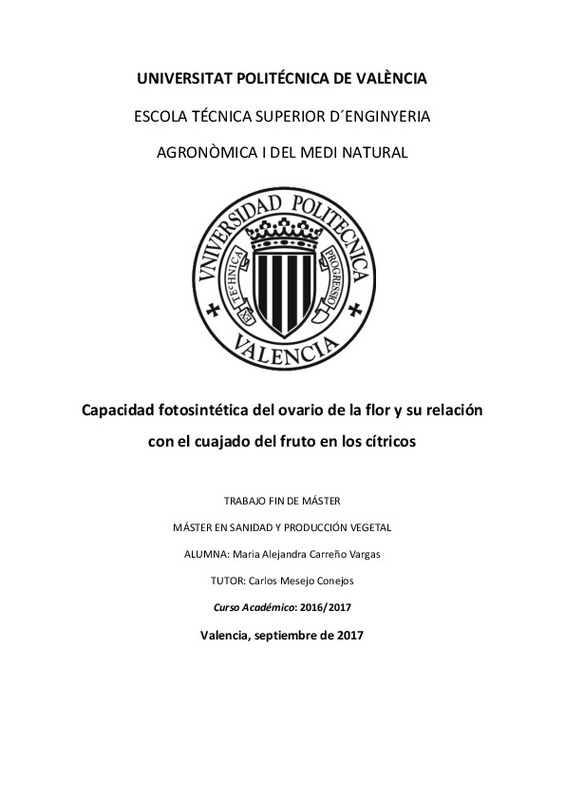JavaScript is disabled for your browser. Some features of this site may not work without it.
Buscar en RiuNet
Listar
Mi cuenta
Estadísticas
Ayuda RiuNet
Admin. UPV
Capacidad fotosintética del ovario de la flor y su relación con el cuajado del fruto en los cítricos
Mostrar el registro sencillo del ítem
Ficheros en el ítem
| dc.contributor.advisor | Mesejo Conejos, Carlos
|
es_ES |
| dc.contributor.author | Carreño Vargas, María Alejandra
|
es_ES |
| dc.date.accessioned | 2017-10-25T06:18:52Z | |
| dc.date.available | 2017-10-25T06:18:52Z | |
| dc.date.created | 2017-09-27 | |
| dc.date.issued | 2017-10-25 | es_ES |
| dc.identifier.uri | http://hdl.handle.net/10251/89966 | |
| dc.description.abstract | Flowering determines the productive success of any commercial crop. Therefore, factors that determine flowering and its influence on the fruit set are of marked importance. The flower to fruit transition is regulated by nutritional and hormonal factors. Nutritional factors determine the supply of photo-assimilates necessary for fruit development, and hormonal factors influence development through the activation of cell division and the sink strength. In recent studies, it was confirmed that the accumulation of starch in the ovary of the flower during the period of pre-anthesis allows the nutritional independence of the flower with respect to the leaves during the initial fruit set. Its hydrolysis would ensure a minimum level of glucose to promote the growth rate of the ovary necessary for setting a fruit, until the young leaves acquire photo-assimilate export capacity. The synthesis of starch in source organs (leaves) differs from the synthesis of starch in sink organs (seeds or fruits). It is not known how citrus starch is synthesized in the ovary, and so, the following working hypothesis is proposed: Starch accumulated in the ovary during the period of preanthesis comes from the sucrose generated by its own photosynthetic capacity and the mobilization of reserves from neighboring sources. To confirm the hypothesis, we have studied the effect of branch defoliation in fruit set of the Clementine mandarin cv. Marisol, the ovary photosynthetic capacity and the distribution of carbohydrates in the plant. | es_ES |
| dc.description.abstract | La floración determina el éxito productivo de cualquier cultivo. Por lo tanto, el conocimiento de los factores endógenos y exógenos que determinen su desarrollo y su influencia sobre el cuajado del fruto es de marcada importancia. Los factores endógenos que condicionan el paso de flor a fruto son de tipo nutricional y hormonal. Los factores nutricionales determinan el abastecimiento de los fotoasimilados necesarios para el desarrollo del fruto, y los factores hormonales influyen en el desarrollo por medio de la activación de la división celular y en la capacidad sumidero o de atracción de nutrientes por parte del fruto en crecimiento. En estudios recientes, se confirmó que la acumulación de almidón en el ovario de la flor durante el periodo de pre antesis permite la independencia nutricional de la flor respecto de las hojas durante el cuajado inicial. Su hidrólisis aseguraría un nivel mínimo de glucosa para promover la tasa de crecimiento del ovario necesaria para el cuajado del fruto, hasta el momento en que las hojas jóvenes adquieran capacidad exportadora de fotoasimilados. La síntesis de almidón en órganos fuente (hojas) difiere de la síntesis de almidón en órganos sumidero (semillas o frutos). Se desconoce cómo se origina el almidón del ovario de la flor de los cítricos, por lo que en esta Tesina de Máster se plantea la siguiente hipótesis de trabajo: El almidón acumulado en el ovario durante el periodo de preantesis proviene de la sacarosa generada por su propia capacidad fotosintética y de la movilización de reservas desde fuentes vecinas. Para confirmar la hipótesis, se ha estudiado el efecto de la defoliación de ramas del mandarino Clementino cv. Marisol en el cuajado y desarrollo del ovario, su capacidad fotosintética y el reparto de carbohidratos en la planta. | es_ES |
| dc.language | Español | es_ES |
| dc.publisher | Universitat Politècnica de València | es_ES |
| dc.rights | Reserva de todos los derechos | es_ES |
| dc.subject | Carbohydrates | es_ES |
| dc.subject | Fruit set | es_ES |
| dc.subject | Photosynthesis | es_ES |
| dc.subject | Carbohidratos | es_ES |
| dc.subject | Citrus | es_ES |
| dc.subject | Cuajado | es_ES |
| dc.subject | Fotosíntesis | es_ES |
| dc.subject.classification | PRODUCCION VEGETAL | es_ES |
| dc.subject.other | Máster Universitario en Sanidad y Producción Vegetal-Máster Universitario en Sanitat y Producció Vegetal | es_ES |
| dc.title | Capacidad fotosintética del ovario de la flor y su relación con el cuajado del fruto en los cítricos | es_ES |
| dc.type | Tesis de máster | es_ES |
| dc.rights.accessRights | Abierto | es_ES |
| dc.contributor.affiliation | Universitat Politècnica de València. Departamento de Producción Vegetal - Departament de Producció Vegetal | es_ES |
| dc.description.bibliographicCitation | Carreño Vargas, MA. (2017). Capacidad fotosintética del ovario de la flor y su relación con el cuajado del fruto en los cítricos. http://hdl.handle.net/10251/89966 | es_ES |
| dc.description.accrualMethod | TFGM | es_ES |
| dc.relation.pasarela | TFGM\67150 | es_ES |






